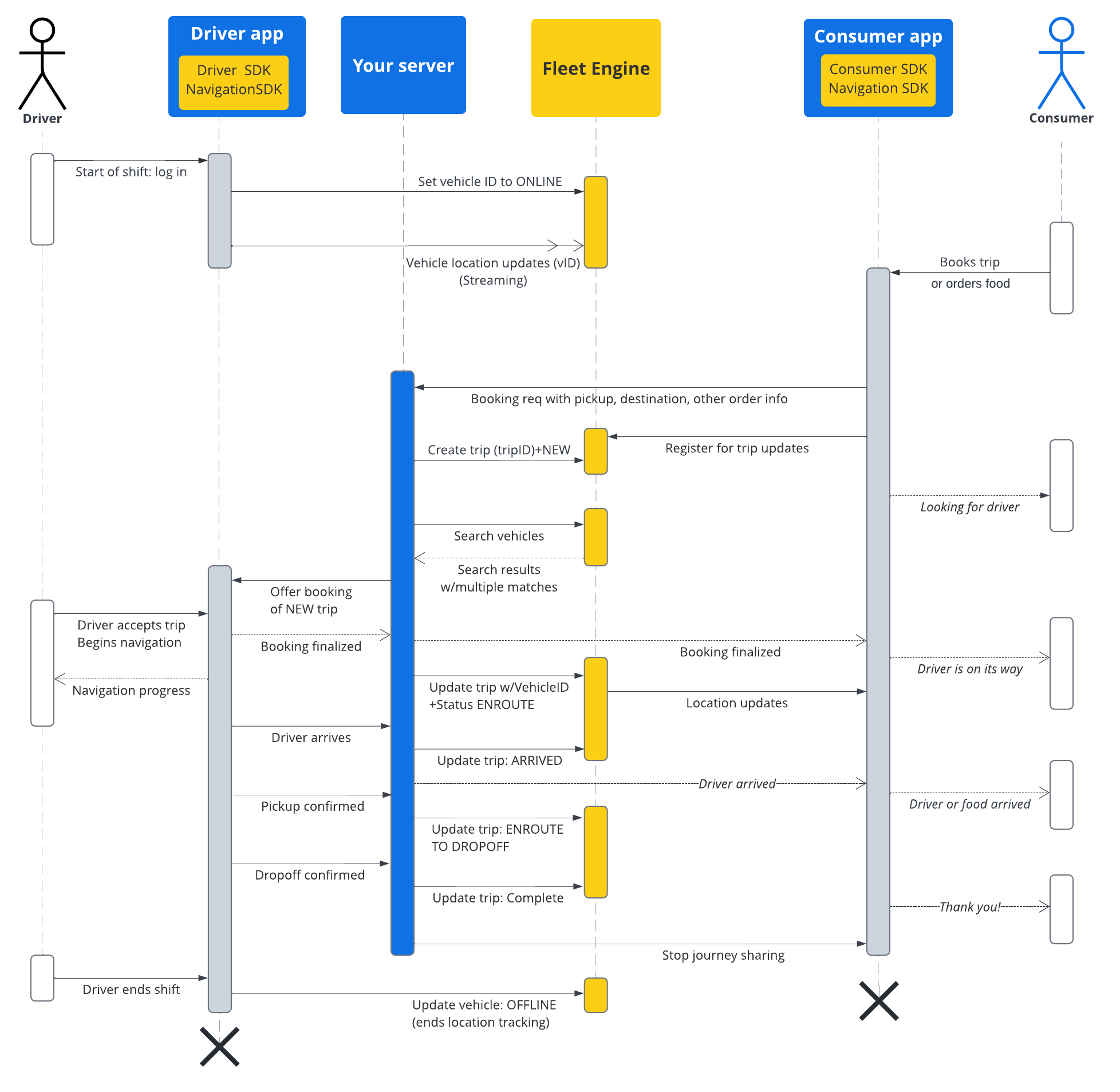このセクションのドキュメントでは、Google Maps Mobility のオンデマンド乗車サービスを使用して乗車を作成し、操作する方法について説明します。以下の内容を理解していることを前提としています。
- Fleet Engine: Fleet Engine の実装の詳細、リクエスト メカニズム、セキュリティについて理解している必要があります。詳細については、Fleet Engine サービスとはと、Fleet Engine を設定するのセキュリティに関するトピックをご覧ください。
- オンデマンド サービスのための車両の基礎知識。車両の概要をご覧ください。
- オンデマンド サービスの旅行の基本情報。オンデマンドの乗車をご覧ください。
使用する TripService は、gRPC と REST で使用できます。わかりやすくするために、フィールド参照は gRPC の規則に従います。
オンデマンド サービスの Fleet Engine では、乗車は、ユーザーからのフード デリバリーや乗車リクエストの履行をモデル化する一種の移動です。旅程には、旅程の進行に応じて Fleet Engine に報告するステータスがあります。NEW 、ENROUTE_TO_PICKUP 、などなど。乗車ステータスは、車両に割り当てられた位置情報付きの経由地に対応しています。Fleet Engine は、ユーザーが行う乗車更新ごとにこれらの車両経由地を変更します。乗車と車両の関係について詳しくは、Fleet Engine の基本事項のオンデマンド乗車をご覧ください。
旅行のライフサイクル
Fleet Engine で各乗車を追跡するには、まず Trip エンティティを作成する必要があります。参考までに、gRPC または REST をご覧ください。
次の表は、システムで作成された旅行のエンドツーエンドのフローの例と、Fleet Engine でのそのライフサイクル ステージを示しています。このガイドでは、Fleet Engine を設定済みで、乗車に割り当てる車両があり、ドライバー アプリで位置情報の更新が有効になっていることを前提としています。Driver SDK: オンデマンド乗車をご覧ください。
| 1 | 予約リクエストを受け取ります。 | Fleet Engine の乗車が開始される前に、まず予約システムがアプリまたは他の予約システムを通じて、ユーザーから乗車または配達のリクエストを受け取ります。システムは、乗車場所などの必須フィールドを含む CreateTrip を使用して、乗車エンティティを作成します。この時点で、乗客や降車場所などの他のフィールドを設定することも、車両が割り当てられるまで待つこともできます。1 つの目的地への旅行を作成するをご覧ください。 |
| 2 | 車両を割り当てます。 | システム内で車両を乗車に直接割り当てて Fleet Engine に割り当てを報告することも、車両の検索サービスを使用して車両を検索し、乗車と車両の両方の属性でフィルタして、乗車を完了する最適な車両を見つけることもできます。検索範囲内のオンライン車両は、Driver SDK が提供する位置情報の更新を通じて、その近接性を知らせます。
|
| 3 | ルートを更新します。 | ドライバーが乗車を承諾し、お迎え場所へのナビゲーションを開始すると、システムは乗車のステータスを NEW から ENROUTE_TO_PICKUP に更新します。アプリからバックエンドへの直接接続、または Driver SDK から車両の位置情報の更新ストリームを継続的に受信する Fleet Engine のポーリングのいずれかを通じて、走行中も車両の位置情報を継続的にポーリングします。システムは各乗車マイルストーンを Fleet Engine に報告し、Fleet Engine はそれに応じて車両のウェイポイント リストを更新します。 |
| 4 | カスタマー ジャーニーをユーザーと共有します。 | Fleet Engine は、Consumer SDK で乗車に関する詳細情報と車両の位置情報を利用できるようにします。Consumer SDK はリスナーを使用して乗車に関する最新情報を受け取り、それをユーザー向けアプリに表示します。Fleet Engine は、到着予定時刻、残りの距離、ルート、残りの車両の経由地を自動的に更新します。詳しくは、オンデマンド乗車で乗車経路を共有するをご覧ください。 |
| 5 | 旅行を完了します。 | 車両が乗車地の経由地に到着し、ドライバーが乗車が完了したことを示すと、システムは Fleet Engine で TripStatus を COMPLETE に設定します。車両と同様に、乗車エンティティはステータスに関係なく Fleet Engine 内で 7 日間アクティブな状態が維持され、その後削除されます。 |
乗車シーケンス フロー
次の図は、このフローの詳細を示しています。


